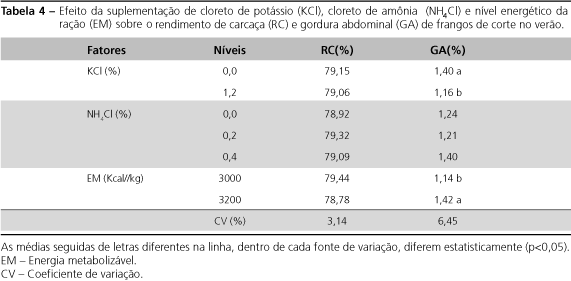Two hundred and forty male broiler chickens with initial average weight of 1,204g, were utilized; in CRD with the treatments in 2 x 3 x 2 factorial design, 2 levels of KCl (0.0%; 1.2 %) x 3 levels of NH4Cl (0.0%; 0.2% and 0.4%) and 2 levels of energy (3,000 and 3,200 kcal ME/kg of ration) with 4 replications of 5 birds per plot. The evaluated parameters were: average weight (AW), feed consumption (FC), weight gain (WG) feed conversion (FC), carcass yield (CY) and abdominal fat (AF). The data were analyzed through the statistical program Statistical Analysis System (SAS, 1996). The maximum and minimum temperatures and black globe-humidity index (BGHI), recorded at 9:00 and 15:00 were (32.7 and 22.8; 76 and 83). The KCl significantly reduced (p<0.05) abdominal fat (AF). Metabolizable energy affected (p<0.05) FC (2.12 vs 2.30) and AF (1.42% vs 1.14%) for the high and low levels, respectively. For the other parameters, no significant effects of the factors studied (p>0.05) were found. Energy level of the ration improved feed conversion and increased abdominal fat; KCl did not affect performance and reduced abdominal fat regardless of the energy level in the diet; and the supplementation with 0.4% NH4Cl reduced feed conversion of broiler chickens raised in summer.
ammonium chlorides; broilers; caloric stress; potassium chloride




